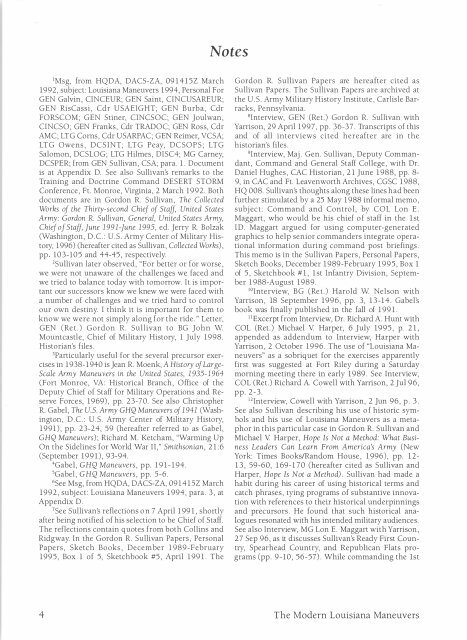The Modern Louisiana Maneuvers - US Army Center Of Military History
The Modern Louisiana Maneuvers - US Army Center Of Military History
The Modern Louisiana Maneuvers - US Army Center Of Military History
You also want an ePaper? Increase the reach of your titles
YUMPU automatically turns print PDFs into web optimized ePapers that Google loves.
lMsg, from HQDA, DACS-ZA, 091415Z March<br />
1992, subject: <strong>Louisiana</strong> <strong>Maneuvers</strong> 1994, Personal For<br />
GEN Galvin, CINCEUR; GEN Saint, CINC<strong>US</strong>AREUR;<br />
GEN RisCassi, Cdr <strong>US</strong>AEIGHT; GEN Burba, Cdr<br />
FORSCOM; GEN Stiner, CINCSOC; GEN Joulwan,<br />
CINCSO; GEN Franks, Cdr TRADOC; GEN Ross, Cdr<br />
AMC; LTG Corns, Cdr <strong>US</strong>ARPAC; GEN Reimer, VCSA;<br />
LT G Owens, DCSINT; LT G Peay, DCSOPS; LT G<br />
Salomon, DCSLOG; LTG Hilmes, DISC4; MG Carney,<br />
DCSPER; from GEN Sullivan, CSA; para. 1. Document<br />
is at Appendix D. See also Sullivan's remarks to the<br />
Training and Doctrine Command DESERT STORM<br />
Conference, Ft. Monroe, Virginia, 2 March 1992. Both<br />
documents are in Gordon R. Sullivan, <strong>The</strong> Collected<br />
Wo rks of the Thirty-second Chief of Staff, United States<br />
<strong>Army</strong>: Gordon R. Sullivan, General, United States <strong>Army</strong>,<br />
Chief of Staff, June 1991-June 1995, ed. Jerry R. Bolzak<br />
(Washington, D.C.: U.S <strong>Army</strong> <strong>Center</strong> of <strong>Military</strong> <strong>History</strong>,<br />
1996) (hereafter cited as Sullivan, Collected Works),<br />
pp 103-105 and 44-45, respectively<br />
2Sullivan later observed, "For better or for worse,<br />
we were not unaware of the challenges we faced and<br />
we tried to balance today with tomorrow. It is important<br />
our successors know we knew we were faced with<br />
a number of challenges and we tried hard to control<br />
our own destiny I think it is important for them to<br />
know we were not simply along for the ride." Letter,<br />
GEN (Ret.) Gordon R. Sullivan to BG John W.<br />
Mountcastle, Chief of <strong>Military</strong> <strong>History</strong>, 1 July 1998.<br />
Historian's files.<br />
3Particularly useful for the several precursor exercises<br />
in 1938-1940 is Jean R. Moenk, A <strong>History</strong> of Large<br />
Scale <strong>Army</strong> <strong>Maneuvers</strong> in the United States, 1935-1964<br />
(Fort Monroe, VA : Historical Branch, <strong>Of</strong>fice of the<br />
Deputy Chief of Staff for <strong>Military</strong> Operations and Reserve<br />
Forces, 1969), pp. 23-70. See also Christopher<br />
R. Gabel, <strong>The</strong> U.S. <strong>Army</strong> GHQ <strong>Maneuvers</strong> of 1941 (Washington,<br />
D.C.: U.S. <strong>Army</strong> <strong>Center</strong> of <strong>Military</strong> <strong>History</strong>,<br />
1991), pp. 23-24, 59 (hereafter referred to as Gabel,<br />
GHQ <strong>Maneuvers</strong>); Richard M. Ketcham, "Warming Up<br />
On the Sidelines for World War II," Smithsonian, 21:6<br />
(September 1991), 93-94.<br />
4Gabel, GHQ <strong>Maneuvers</strong> , pp. 191-194.<br />
5Gabel, GHQ <strong>Maneuvers</strong> , pp. 5-6.<br />
6See Msg, from HQDA, DACS-ZA, 091415Z March<br />
1992, subject: <strong>Louisiana</strong> <strong>Maneuvers</strong> 1994, para. 3, at<br />
Appendix D.<br />
7See Sullivan's reflections on 7 April 1991 , shortly<br />
after being notified of his selection to be Chief of Staff.<br />
<strong>The</strong> reflections contain quotes from both Collins and<br />
Ridgway In the Gordon R. Sullivan Papers, Personal<br />
Papers, Sketch Books, December 1989-February<br />
1995, Box 1 of 5, Sketchbook #5 , April 1991. <strong>The</strong><br />
4<br />
Notes<br />
Gordon R. Sullivan Papers are hereafter cited as<br />
Sullivan Papers. <strong>The</strong> Sullivan Papers are archived at<br />
the U.S. <strong>Army</strong> <strong>Military</strong> <strong>History</strong> Institute, Carlisle Barracks,<br />
Pennsylvania.<br />
8Interview, GEN (Ret.) Gordon R. Sullivan with<br />
Yarrison, 29 April 1997, pp. 36-37. Transcripts of this<br />
and of all interviews cited hereafter are in the<br />
historian's files.<br />
9Interview, Maj . Gen. Sullivan, Deputy Commandant,<br />
Command and General Staff College, with Dr.<br />
Daniel Hughes, CAC Historian, 21 June 1988, pp. 8-<br />
9, in CAC and Ft. Leavenworth Archives, CGSC 1988,<br />
HQ 008. Sullivan's thoughts along these lines had been<br />
further stimulated by a 25 May 1988 informal memo,<br />
subject: Command and Control, by COL Lon E.<br />
Maggart, who would be his chief of staff in the 1st<br />
ID. Maggart argued for using computer-generated<br />
graphiCS to help senior commanders integrate operational<br />
information during command post briefings.<br />
This memo is in the Sullivan Papers, Personal Papers,<br />
Sketch Books, December 1989-February 1995, Box 1<br />
of 5, Sketchbook #1, 1st Infantry Division, September<br />
1988-August 1989.<br />
lOInterview, BG (Ret.) Harold W. Nelson with<br />
Yarrison, 18 September 1996, pp. 3, 13-14. Gabel's<br />
book was finally published in the fall of 1991.<br />
llExcerpt from Interview, Dr. Richard A. Hunt with<br />
COL (Ret.) Michael V Harper, 6 July 1995, p. 21,<br />
appended as addendum to Interview, Harper with<br />
Yarrison, 2 October 1996. <strong>The</strong> use of "<strong>Louisiana</strong> <strong>Maneuvers</strong>"<br />
as a sobriquet for the exercises apparently<br />
first was suggested at Fort Riley during a Saturday<br />
morning meeting there in early 1989. See Interview,<br />
COL (Ret.) Richard A. Cowell with Yarrison, 2 Ju1 96,<br />
pp. 2-3.<br />
12Interview, Cowell with Yarrison, 2 Jun 96, p. 3.<br />
See also Sullivan describing his use of historic symbols<br />
and his use of <strong>Louisiana</strong> <strong>Maneuvers</strong> as a metaphor<br />
in this particular case in Gordon R. Sullivan and<br />
Michael V Harper, Hope Is Not a Method: What Business<br />
Leaders Can Learn From America's <strong>Army</strong> (New<br />
York: Times Books/Random House, 1996), pp. 12-<br />
13, 59-60, 169-170 (hereafter cited as Sullivan and<br />
Harper, Hope Is Not a Method) . Sullivan had made a<br />
habit during his career of using historical terms and<br />
catch phrases, tying programs of substantive innovation<br />
with references to their historical underpinnings<br />
and precursors . He found that such historical analogues<br />
resonated with his intended military audiences.<br />
See also Interview, MG Lon E. Maggart with Yarrison,<br />
27 Sep 96, as it discusses Sullivan's Ready First Country,<br />
Spearhead Country, and Republican Flats programs<br />
(pp. 9-10, 56-57) . While commanding the 1st<br />
<strong>The</strong> <strong>Modern</strong> <strong>Louisiana</strong> <strong>Maneuvers</strong>
















